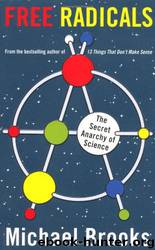Free Radicals by Michael Brooks

Author:Michael Brooks
Language: eng
Format: mobi, epub
Tags: Science
ISBN: 9781846684050
Publisher: Profile Books
Published: 2011-07-07T00:00:00+00:00
FIGHT CLUB
There’s no prize for the runner-up
‘I
played over the music of that scoundrel Brahms. What a giftless bastard. It annoys me that this jumping, inflated mediocrity is hailed as a genius.’ That was Tchaikovsky’s assessment of one of his more celebrated contemporaries. Such attitudes run through the history of the arts. Louis Spohr, a German violinist and composer, called Beethoven’s Fifth Symphony an ‘orgy of vulgar noises’. Édouard Manet wrote to his colleague Claude Monet about Renoir in less than glowing terms: ‘He has no talent at all, that boy. Tell him to give up painting.’
The arts, though, are a sycophant’s paradise compared with the sciences. At least the artists snipe about their colleagues behind their backs; scientists do it face to face. ‘Our speaker today is a man about whom we have heard so much, and from whom we have seen so little.’ That was the chemist Gilbert Lewis’s introduction when Irving Langmuir visited his department to give a seminar. Four years later, on 23 March 1946, an hour or so after having lunch with Langmuir, Lewis was found dead in his laboratory. The air was filled with the scent of almonds – and a flask of hydrogen cyanide was open on the laboratory bench.
To this day, no one knows whether Lewis killed himself, whether it was an accident, or whether something more disturbing took place. No autopsy was ever carried out on Lewis’s body. In Cathedrals of Science, a fascinating dissection of the history of chemistry, Patrick Coffey uncovers a trail of lies and half-truths linked to the incident. Langmuir’s visit to Berkeley that day was conveniently airbrushed out of the story for nearly sixty years. In Langmuir’s writings, dates were fudged: he visited the University of California in ‘1945 or 1946’ according to his celebrated ‘Pathological Science’ essay in which he takes Lewis’s science to pieces. Joel Hildebrand, who organised the lunch, later wrote – erroneously – that it was in 1945. Whether that was a subconscious slip or a deliberate attempt to remove Langmuir from the vicinity of Berkeley at the time of Lewis’s death, we will never know. Everyone involved is now dead.
Coffey concludes that Lewis most probably had a heart attack in his laboratory while he was working with hydrogen cyanide. He had led an unhealthy, tobacco-fuelled, hate-filled life and was a prime candidate for heart failure. But he was also depressed, and others felt that suicide was the most likely scenario. Murder is inconceivable. Or at least no one seems to mention it as a possibility.
Anyway, it was not necessary: in scientific terms, Langmuir had already killed Lewis. Langmuir had won a Nobel Prize for work that Lewis considered his own. Lewis had sown the seeds of his own destruction, though, by making bitter enemies of two chemists who were highly influential in Stockholm. Walther Nernst and Svante Arrhenius hated each other; Arrhenius had managed to block Nernst’s much-deserved Nobel Prize for fifteen years. But Lewis gave them a common enemy. In a 1907 paper he had called some of their work ‘unsystematic’ and ‘inexact’.
Download
This site does not store any files on its server. We only index and link to content provided by other sites. Please contact the content providers to delete copyright contents if any and email us, we'll remove relevant links or contents immediately.
| Africa | Americas |
| Arctic & Antarctica | Asia |
| Australia & Oceania | Europe |
| Middle East | Russia |
| United States | World |
| Ancient Civilizations | Military |
| Historical Study & Educational Resources |
Cecilia; Or, Memoirs of an Heiress — Volume 1 by Fanny Burney(32440)
Cecilia; Or, Memoirs of an Heiress — Volume 2 by Fanny Burney(31875)
Cecilia; Or, Memoirs of an Heiress — Volume 3 by Fanny Burney(31858)
The Secret History by Donna Tartt(18862)
Sapiens: A Brief History of Humankind by Yuval Noah Harari(14258)
Leonardo da Vinci by Walter Isaacson(13190)
The Radium Girls by Kate Moore(11935)
Sapiens by Yuval Noah Harari(5297)
How Democracies Die by Steven Levitsky & Daniel Ziblatt(5134)
The Wind in My Hair by Masih Alinejad(5036)
Homo Deus: A Brief History of Tomorrow by Yuval Noah Harari(4828)
Endurance: Shackleton's Incredible Voyage by Alfred Lansing(4685)
The Silk Roads by Peter Frankopan(4461)
Man's Search for Meaning by Viktor Frankl(4435)
Millionaire: The Philanderer, Gambler, and Duelist Who Invented Modern Finance by Janet Gleeson(4386)
The Rape of Nanking by Iris Chang(4141)
Joan of Arc by Mary Gordon(4023)
The Motorcycle Diaries by Ernesto Che Guevara(4020)
Hitler in Los Angeles by Steven J. Ross(3902)
